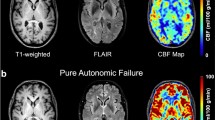Abstract
Even though the medulla contains the baroreceptor regulatory centers, few studies have focused on the autonomic dysfunction of lateral medullary infarction (LMI). Therefore, cardiac parasympathetic and sympathetic functions were compared in LMI patients and age-matched controls. We prospectively recruited 25 LMI patients who had ipsilateral Horner’s sign and cardiac autonomic function testing without a history of diabetes, cardiac disease, or previous stroke. Parasympathetic function tests included beat-to-beat heart rate variation during deep breathing, 30:15 heart rate ratio testing while standing, and the valsalva ratio. Sympathetic function tests included blood pressure during active standing and sustained handgrip. The composite autonomic score (CAS) was measured as a total of 10 points; parasympathetic dysfunction was designated as ≥3 points in the parasympathetic subscores and sympathetic dysfunction as ≥2 points in the sympathetic subscores. Multiple regression analysis was performed to predict parasympathetic or sympathetic dysfunction. The mean age and stroke risk factors of the study population were not significantly different between the LMI group (n = 25) and control group (n = 29). However, cardiac autonomic functions were significantly different in the groups: parasympathetic dysfunction (14 vs. 4 patients, p = 0.011) and sympathetic dysfunction (3 vs. 13 patients, p = 0.008). In univariate analysis, male-gender (p = 0.011), right-side involvement (p = 0.035) and ventral involvement (p = 0.007) were significantly associated with parasympathetic dysfunction (CAS subscore ≥3). In multivariable analysis, the ventral involvement remained to be the independent predictor for parasympathetic dysfunction (OR 16.0; 95 % CI 2.2–118.3, p = 0.007). This study suggests that LMI patients are susceptible to cardiac parasympathetic dysfunction, especially in the ventral medulla.


Similar content being viewed by others
References
Sacco RL, Freddo L, Bello JA, Odel JG, Onesti ST, Mohr JP (1993) Wallenberg’s lateral medullary syndrome. Clinical-magnetic resonance imaging correlations. Arch Neurol 50:609–614
Kim JS (2003) Pure lateral medullary infarction: clinical-radiological correlation of 130 acute, consecutive patients. Brain 126:1864–1872
Currier RD, Giles CL, Dejong RN (1961) Some comments on Wallenberg’s lateral medullary syndrome. Neurology 11:778–791
Norrving B, Cronqvist S (1991) Lateral medullary infarction: prognosis in an unselected series. Neurology 41:244–248
Dampney RA, Horiuchi J, Tagawa T, Fontes MA, Potts PD, Polson JW (2003) Medullary and supramedullary mechanisms regulating sympathetic vasomotor tone. Acta Physiol Scand 177:209–218
Sykora M, Diedler J, Poli S, Rupp A, Turcani P, Steiner T (2010) Blood pressure course in acute stroke relates to baroreflex dysfunction. Cerebrovasc Dis 30:172–179
Phillips AM, Jardine DL, Parkin PJ, Hughes T, Ikram H (2000) Brain stem stroke causing baroreflex failure and paroxysmal hypertension. Stroke 31:1997–2001
Gandhavadi B (1988) Hypertension after brainstem stroke. Arch Phys Med Rehabil 69:130–131
Meglic B, Kobal J, Osredkar J, Pogacnik T (2001) Autonomic nervous system function in patients with acute brainstem stroke. Cerebrovasc Dis 11:2–8
Flachenecker P, Wermuth P, Hartung HP, Reiners K (1997) Quantitative assessment of cardiovascular autonomic function in Guillain-Barre syndrome. Ann Neurol 42:171–179
Kim JS, Lee JH, Suh DC, Lee MC (1994) Spectrum of lateral medullary syndrome. Correlation between clinical findings and magnetic resonance imaging in 33 subjects. Stroke 25:1405–1410
Kim H, Chung CS, Lee KH, Robbins J (2000) Aspiration subsequent to a pure medullary infarction: lesion sites, clinical variables, and outcome. Arch Neurol 57:478–483
Lassman AB, Mayer SA (2005) Paroxysmal apnea and vasomotor instability following medullary infarction. Arch Neurol 62:1286–1288
Syme P (2005) Are cardiac syndrome X, irritable bowel syndrome and reflex sympathetic dystrophy examples of lateral medullary ischaemic syndromes? Med Hypotheses 65:145–148
Korpelainen JT, Sotaniemi KA, Makikallio A, Huikuri HV, Myllyla VV (1999) Dynamic behavior of heart rate in ischemic stroke. Stroke 30:1008–1013
Korpelainen JT, Sotaniemi KA, Suominen K, Tolonen U, Myllyla VV (1994) Cardiovascular autonomic reflexes in brain infarction. Stroke 25:787–792
Spyer KM (1994) Annual review prize lecture: central nervous mechanisms contributing to cardiovascular control. J Physiol 474:1–19
Guyenet PG (2006) The sympathetic control of blood pressure. Nat Rev Neurosci 7:335–346
Machado BH, Brody MJ (1988) Role of the nucleus ambiguus in the regulation of heart rate and arterial pressure. Hypertension 11:602–607
Benarroch EE, Schmeichel AM, Sandroni P, Low PA, Parisi JE (2006) Involvement of vagal autonomic nuclei in multiple system atrophy and Lewy body disease. Neurology 66:378–383
Travagli RA, Hermann GE, Browning KN, Rogers RC (2006) Brainstem circuits regulating gastric function. Annu Rev Physiol 68:279–305
Ketch T, Biaggioni I, Robertson R, Robertson D (2002) Four faces of baroreflex failure: hypertensive crisis, volatile hypertension, orthostatic tachycardia, and malignant vagotonia. Circulation 105:2518–2523
Groves DA, Brown VJ (2005) Vagal nerve stimulation: a review of its applications and potential mechanisms that mediate its clinical effects. Neurosci Biobehav Rev 29:493–500
George MS, Sackeim HA, Rush AJ et al (2000) Vagus nerve stimulation: a new tool for brain research and therapy. Biol Psychiatry 47:287–295
Conflict of interest
None.
Author information
Authors and Affiliations
Corresponding author
Electronic supplementary material
Below is the link to the electronic supplementary material.
Rights and permissions
About this article
Cite this article
Hong, J.M., Kim, T.J., Shin, D.H. et al. Cardiovascular autonomic function in lateral medullary infarction. Neurol Sci 34, 1963–1969 (2013). https://doi.org/10.1007/s10072-013-1420-y
Received:
Accepted:
Published:
Issue Date:
DOI: https://doi.org/10.1007/s10072-013-1420-y




